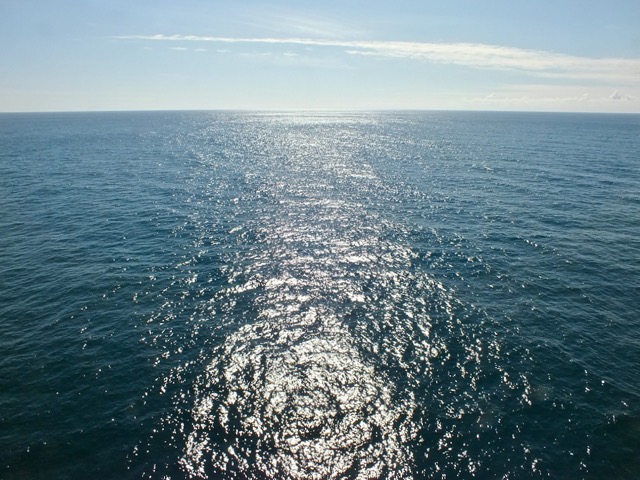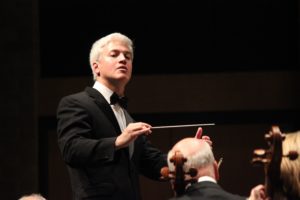 Boise Phil’s The Sea, part of their Classic Series of concerts, shows why the Boise Philharmonic with Musical Director Eric Garcia continues to think outside the box to come up with new, creative ways to provide interesting connections to their programs. The concert showcased Benjamin Britten’s Four Sea Interludes from Peter Grimes, a selection that takes four musical landscapes from Britten’s opera Peter Grimes, nominally a story about a fisherman; and turns them into a standalone concert piece. The Boise Phil’s rendition of this was superb, evoking images of the sea and the shore. By removing these four orchestral pieces and putting them as a separate orchestral suite, Britten allows the music to speak for itself and the generate more of a feeling of the different states of the sea, without being sublimated to just background music for Britten’s operatic story.
Boise Phil’s The Sea, part of their Classic Series of concerts, shows why the Boise Philharmonic with Musical Director Eric Garcia continues to think outside the box to come up with new, creative ways to provide interesting connections to their programs. The concert showcased Benjamin Britten’s Four Sea Interludes from Peter Grimes, a selection that takes four musical landscapes from Britten’s opera Peter Grimes, nominally a story about a fisherman; and turns them into a standalone concert piece. The Boise Phil’s rendition of this was superb, evoking images of the sea and the shore. By removing these four orchestral pieces and putting them as a separate orchestral suite, Britten allows the music to speak for itself and the generate more of a feeling of the different states of the sea, without being sublimated to just background music for Britten’s operatic story.
The second part of the Boise Phil’s The Sea concert provided a fresh interpretation of possibly the most famous of any composition about the ocean, Claude Debussy’s La Mer. La Mer, literally French for The Sea, is a group of three symphonic sketches about different aspects of the sea and the interplay of nature. The first, From Dawn to Noon at the Sea, is a slow, relaxing image of a generally peaceful sea. The subtle textures of this were well brought out by the Boise Phil, with the orchestra’s dynamic performance creating a musical interpretation that nicely showcased Debussy’s vision of the start of the day upon a peaceful sea.
The second sketch, Play of the Waves, gave the Boise Phil a chance to open up and provide a playful view of the afternoon sea. Musically, this was a chance for the Boise Phil’s fine musicians to create a strong and vibrant feeling of the ocean’s normal state, the musical version of whitecaps and swells on the surface. Finally, the climactic Dialogue of Wind and Sea (or Wind and Waves) brought a tumultuous feeling to the audience, not quite a storm but rather a feeling of the sea’s power and majesty. Here again, the Boise Phil was up to the task, with Maestro Eric Garcia’s spirited conducting wringing out every bit of emotion as the wind and waves pick up to a musical squall. Bringing Debussy’s musical version to life, you could almost feel the droplets and spray on your face as the music created rough seas and an exciting conclusion. With the Boise Phil’s The Sea, the Philharmonic created not just a pastiche of the usual composers but helped to create a theme that the audience clearly enjoyed.

Capping the evening, the program moved away from the ocean and into a much more intimate musical view. Edward Elgar, best known for the Pomp and Circumstance March, was a hugely popular composer when he composed the Enigma Variations. The series of fourteen musical portraits of Elgar’s friends and acquaintances, was introduced by Maestro Garcia with the suggestion that following the names or initials of each of the variations may give the audience a chance for some insight as to the person that Elgar was trying to “paint”. One of the best features of this piece is the instrumentation, allowing many of the Boise Phil’s musicians to be highlighted in different sections. With some variations being subtle and sentimental while others highly animated and brash, the Enigma Variations was an opportunity to really see what the Boise Phil can do with a dynamic piece.
The Boise Phil has proved itself very adept at making good music accessible to people of all tastes, from devout lovers of Classical Romantic composers to fans of Hollywood blockbuster movie music. With the Boise Phil’s The Sea program, the orchestra certainly provided a musical evening that took the audience from interpretations of the smallest personality to the large expanse of The Sea.
Boise Phil website and concert schedules
Photo of Eric Garcia courtesy of the Boise Phil. Photo of Sunlight on the Ocean by Ed Simon.











